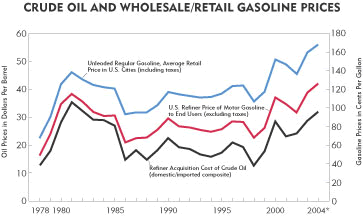 In May gas stations across the district posted prices above $2 per gallon, just in time for the summer driving season. But before anyone accuses gas stations of trying to take advantage of summer travelers, there are several factors to consider that contribute to changes in gas prices.
In May gas stations across the district posted prices above $2 per gallon, just in time for the summer driving season. But before anyone accuses gas stations of trying to take advantage of summer travelers, there are several factors to consider that contribute to changes in gas prices.
The retail market for gasoline has many competitors, making it difficult for one retailer to set prices independent of other sellers. Gasoline is a product that is basically the same from gas station to gas station. Furthermore, a manager of a gasoline retailer can easily match competitors' price swings by changing a few digits on a roadside sign.
Some retailers choose to charge slightly higher or lower prices relative to their closest competitors, in part due to the mix of other products or services sold at the station or the convenience of its location. However, price changes for the retail market as a whole are primarily influenced by the underlying costs for gasoline, including the price of oil, government regulations and taxes, refining capacity and transportation costs (see chart). According to a study by the Energy Information Administration (EIA), if the wholesale gasoline price increases by 10 cents, retail price increases of about 6 cents are expected within two weeks and 10 cents within six weeks.

Source: Energy Information Administration
*February 2004
Oil represents the largest component of the cost of gasoline. The price of oil is largely influenced by Organization of Petroleum Exporting Countries. OPEC includes 11 developing countries that supply 40 percent of the world's oil. These countries agree on the amount of oil each country produces to keep oil prices within a range that accrues the most profit. If the price moves above or below the range, OPEC estimates that profitability would decline among its members.
Nevertheless, during the last 20 years oil has traded as low as $11 per barrel and more recently as high as $40. Changes in global economic conditions, political instability in oil exporting countries and other factors influence oil markets.
| GASOLINE PRICE COMPONENTS | |
|---|---|
| Percent of Total | Cost per Gallon |
|
100
90 |
18
Distribution/Marketing |
|
80
70 |
40
Refining |
|
60
50 40 |
41
Federal and State Taxes |
|
30
20 10 0 |
81
Crude Oil |
|
April 2004
Average Retail Price: $1.80 per Gallon
|
|
Federal, state and local taxes represented about one-fourth of the retail price of gasoline in 2003. Differences in state and local taxes contribute to the differences in retail prices among states (see map). Furthermore, some parts of the country, such as California, Minnesota and the Chicago-Milwaukee area, require gas formulations that produce less pollution, but often are more expensive than conventional formulas.
Refining crude oil into petroleum products represents 19 percent of the price for gasoline. In addition, once the product leaves the refinery, it is transported first by pipelines, tankers or barges, and then by trucks to retailers. States that are farther away from refineries have higher transportation costs, which lead to higher retail prices relative to states that are closer to refineries.
Constraints to refining capacity can lead to changes in wholesale gasoline prices. When refineries require unexpected maintenance, or regularly scheduled maintenance runs longer than anticipated, supply can tighten and wholesale prices increase. For example, a Minnesota refinery (one of eight refineries in the Ninth District) recently had equipment problems and was forced to reduce production.
Earlier this spring oil prices jumped in large part due to instability in the Middle East and strong global demand, particularly to serve the energy needs of swiftly growing China. According to The Economist magazine, China accounted for one-third of the growth in global oil consumption in 2003.
In addition to higher oil prices, seasonal maintenance at refineries led to constraints on gasoline supply. Furthermore, with the domestic summer tourism season fast approaching and gasoline consumption higher than a year ago, expected demand looked strong.
Due to this mix of supply and demand factors, nominal gasoline prices increased to record highs. However, when taking into account the effect of inflation on the prices of all goods and services, the cost of gasoline from 1979 into the early 1980s cost well over $2 per gallon relative to 2004 dollars. Prices would have to reach $2.85 to top the 1981 price of gasoline in real terms.
However, by the time this story goes to press, a growing U.S. economy could put even more pressure on oil supply and delivery systems, and any glitches could mean still-higher prices. Conversely, oil supplies could increase and prices could ease, leading to decreases in retail prices. And before one complains that gas prices fall at a slower pace than they increase, studies by the EIA suggest that retail prices drop in response to lower wholesale prices as fast as they increase in response to higher wholesale prices.





